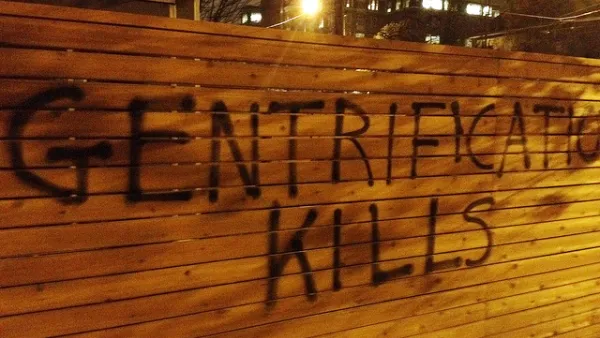A new study by the Federal Reserve Bank of Cleveland examines a “troubling consistency” of neighborhoods—that is that over the past 30 years, the poorest neighborhoods have stayed that way.
Emily Badger details a new study from the Federal Reserve Bank of Cleveland that identifies a trend of urban America: neighborhoods change very little over time with respect to the wealth or poverty of residents.
In summary: “Over the last 30 years, the poorest neighborhoods in urban America have largely remained that way. The depressing realities: Areas that had high unemployment and low average family incomes in 1980 are by and large the same places that had high unemployment and low average family incomes in 2008.”
The real value of the study, according to Badger’s analysis, are the examples provided by neighborhoods where residents did manage to raise their average incomes. “In thinking about how to change the fate of persistently poor neighborhoods, it's helpful to look more closely at what happened in the third of those neighborhoods that did see income growth over this time period.”
The finding of the study: “The areas that saw income growth, however, had significantly higher population density. And by 2008, their total population and density would grow even more.”
Badger acknowledges that “saying that poor neighborhoods in thriving cities fare better than poor neighborhoods in stagnant ones…seems fairly self-evident.” But an important implication emerges from that realization: “Your economic prospects as an individual are influenced by many factors outside of your control…”
The article also raises a final question, “the holy grail” of this direction of inquiry: “Within these previously poor neighborhoods, who is benefiting from the gains in income?”
FULL STORY: What we know about how poor neighborhoods become wealthier

National Parks Layoffs Will Cause Communities to Lose Billions
Thousands of essential park workers were laid off this week, just before the busy spring break season.

Retro-silient?: America’s First “Eco-burb,” The Woodlands Turns 50
A master-planned community north of Houston offers lessons on green infrastructure and resilient design, but falls short of its founder’s lofty affordability and walkability goals.

Delivering for America Plan Will Downgrade Mail Service in at Least 49.5 Percent of Zip Codes
Republican and Democrat lawmakers criticize the plan for its disproportionate negative impact on rural communities.

Test News Post 1
This is a summary

Test News Headline 46
Test for the image on the front page.

Balancing Bombs and Butterflies: How the National Guard Protects a Rare Species
The National Guard at Fort Indiantown Gap uses GIS technology and land management strategies to balance military training with conservation efforts, ensuring the survival of the rare eastern regal fritillary butterfly.
Urban Design for Planners 1: Software Tools
This six-course series explores essential urban design concepts using open source software and equips planners with the tools they need to participate fully in the urban design process.
Planning for Universal Design
Learn the tools for implementing Universal Design in planning regulations.
EMC Planning Group, Inc.
Planetizen
Planetizen
Mpact (formerly Rail~Volution)
Great Falls Development Authority, Inc.
HUDs Office of Policy Development and Research
NYU Wagner Graduate School of Public Service




























